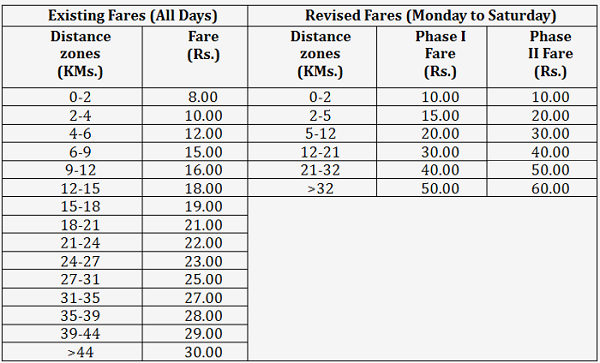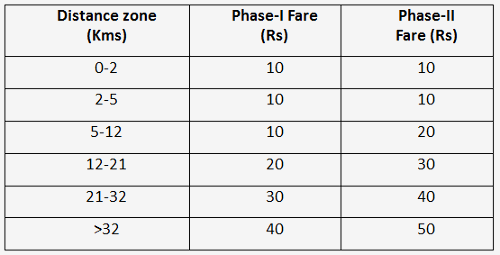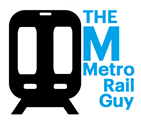Delhi Metro’s New Fares to Go Live in 2 Phases on May 10 & Oct 1
The Delhi Metro’s much needed 4th fare revision will go live this Wednesday (May 10) after the Delhi Metro Rail Corporation’s board approved a fare hike recommended by a 3-member fare fixation committee (FFC) set up under the Delhi Metro Rail (Operation & Maintenance) Act, 2002. Fares or ticket prices were last revised in 2009, and since then, both its network and ridership have more than doubled from 9 lakh to 27 lakh (daily ridership) and from 90 km to 213 km (network) while operating expenses have substantially gone up.
Under the new fare chart, fares will be organized and streamlined in 6 fare slabs against the existing 15 slabs, with the minimum price going up from Rs.8 to Rs.10 and the maximum price going up from Rs.30 to Rs.50 (Phase 1: May 10 – Sept 30) and Rs.60 (Phase 2: October 1 – onwards).
Existing and revised new fares:

Delhi Metro’s existing and new fares – Source: DMRC
According to the DMRC, the above rounded figures would also help in eliminating the shortage of coins and assist in dispensing change to commuters.
With a view to encourage ridership on Sundays and national holidays (26th January, 15th August and 2nd October), the following special discounted fares were approved:

Source: DMRC
The DMRC will continue to provide 10% discounts on fares for smart card users who exit the system during off peak hours. Fares on the Airport Express Line will remain unchanged, and special tourist cards of 1-day and 3-day validity for Rs.200 and Rs.500 will also be available.
To give a little background, the DMRC had been demanding a fare hike for a long time, citing increasing operational costs (electricity, labor, maintenance expenses) that it was unable to recover from traditional fare collection and other sources of revenue such as advertisements. They had been incurring an overall net loss over the past couple of years (see DMRC’s annual reports), and its MD had written to the Ministry of Urban Development (MoUD) multiple times to marginally increase fares to improve the organization’s health in order to continue safe operations and provide regular maintenance to the system.
As per the DMRC, this fare revision was necessary in light of:
increase in the cost of inputs viz. the staff costs, the cost of energy and the cost of repair & maintenance. Since constitution of the 3rd FFC, there has been increase in the rate of industrial DA by 95.5% (from 16.90% to 112.40%), rate of Central DA by 103% (from 22% to 125%) and average increase in the rate of minimum wages by 156.2%. The last fare revision took place in 2009 and the 4th FFC was set up after almost 07 years
In May 2016, the MoUD finally set up a fare fixation committee to look into the DMRC’s proposal. Although their suggestions were received in early 2017, both the Central and Delhi governments were not in favor of implementing the revision due to the municipal polls which just concluded in April.
While this fare revision might not be good news for users, they must take it in a positive manner as it will provide a necessary boost to the organization’s health so that it can continue providing self-sustaining regular services with proper maintenance, all of which makes the system so great.
For more updates, check out the Delhi section of The Metro Rail Guy!
– TMRG




27 lakh is the daily ridership. Not annual.
Ooops, just fixed it. Thanks.
From 1st of October only the maximum fare will be increased to INR 60 or the minimum fare will also be increased from INR 10?
Nope – will remain Rs.10. See the last column in the 1st image.
In my opinion Delhi Metro should have kept same existing distance zones, and fare should have been 10, 15 , 20, 25, 30, 35 and 40 (i.e increment by Rs. 5).
Increase in fares will reduce metro ridership by atleast 15-20%, since even now it is cheaper to go by two wheeler to reach your destination than metro. Also time taken by two wheeler for one hour journey is approx. 15-30 min less than metro.
For taking metro, Step 1: take e-rikha/scotter etc to reach station : Rs .10-20 ( 10-15 min ), Step 2: reach station by climbing at least 3-4 stories (most stations does not have escalators on both side) add 5-10 min, Step 3 : take train 20-40 min, Step 4 : get down and take again e-rikha etc (Rs. 10-20 ) plus 10-15 min. So going to your destination, it takes atleast 20-40 minutes more than your personnel vehicle.
Also metro during peak hours are so crowded you hardly get a space even to stand properly.
Now people of Delhi will have to look for alternate options.
Therefore I would request metro to streamline fare, instead of increasing by 60 to 90 %
I agree with the presentation.
I Agree. I think the rise in fares is more than what was required. A typical one way ride for office goers would now cost around ₹50-70. Spending ₹100-150/day just on travelling that too after investing extra time. This would surely discourage Metro usage.
After Opening up of Heritage, Pink & Magenta lines, the connectivity would enhance leading to a huge rise in footfall and possibly even revenue. So, Metro would have opportunities to reduce its debt in future.
The present hike would only lead to more congestion on roads, including the ones which connect metro stations, and we are expected to see more vehicular pollution.
just fixed one time fare